Weddings are long, high-energy marathons, so what you wear as a photographer can make or break your day. Wedding guests might be in heels and ruffles, but you need to move fast, bend low, and sometimes crawl under a table or dash through a field. You have to look professional—brides and grooms expect it—but blending in with guests is just as important so you’re not the center of attention.
The sweet spot? Outfits that feel like work gear but pass as wedding-wear. Think black or dark neutrals—these colors look elegant yet help you fade into the background. Avoid loud prints or anything too trendy; the goal isn’t to impress with the latest runway vibes. You want to look polished, but never distract from the couple you’re shooting. And always check with the couple about dress code or cultural traditions—sometimes jeans and sneakers just won’t cut it.
- Balancing Style and Function
- Picking the Right Footwear
- Weather, Venue, and Culture
- Useful Accessories and Smart Layering
Balancing Style and Function
If you’re a female photographer at a wedding, you’ve probably noticed there’s a fine line between looking sharp and staying comfortable enough to work a 10-hour shift. Let’s be honest—nobody remembers how the photographer was dressed, but everyone remembers if you look out of place or can’t keep up.
Go for classic pieces that move with you. A collared blouse or modest top works for almost any theme, and dark, stretchy pants are a lifesaver. Leggings that look like dress pants, or tailored trousers with a little give, let you kneel, squat, or climb up on a chair for that wide dance floor shot. Dresses do work, but only if they’re a good length (think midi or below the knee) and aren’t restrictive. Avoid low necklines and anything strapless—you’re often reaching up or crouching down, and wardrobe malfunctions are a no-go.
The secret is looking professional without being flashy. Many pros stick with black; it’s not just about the classic look—darker colors hide inevitable dirt, plus you’ll blend into the crowd. Wedding photographer Sarah Wilkes puts it plainly:
"The best outfits are the ones you don’t have to fuss with. If you’re pulling at your clothes all day, your photos—and your mood—will suffer."
An extra tip—avoid noisy fabrics. That cute vinyl blazer might look cool, but squeaky sleeves will make you the unwanted entertainment during the vows.
| Clothing Item | Best Features for Photography |
|---|---|
| Blouses/Shirts | Moisture-wicking, breathable, non-restrictive |
| Pants/Leggings | Stretch, reinforced knees, stain-resistant |
| Dresses | Midi length or longer, stretchy, pockets |
| Blazers/Jackets | Tailored fit, lightweight, quiet fabric |
If you want a safe bet—layering always wins. Weddings can move from hot afternoon sun to breezy evening in no time, and you don’t want to shiver or sweat while you work. A neat blazer or cardigan over a simple top can save the day. Just skip anything that flaps or drags; you’re there to catch the action, not trip over your clothes.
Picking the Right Footwear
If you ask any female photographer what matters most on a wedding day (besides good camera gear), shoes are usually at the top of the list. You’re going to cover way more ground than the average guest—many pros clock up 5 to 8 miles on a wedding day, according to step counters. Comfort isn’t up for debate here; blisters or sore feet can totally kill your focus.
Forget anything with high heels, slick soles, or that cute-but-slippery ballet flat. Closed-toe shoes are a must—nobody wants a stubbed toe or trampled foot while dodging the crowd or stepping backward for a shot. What works best are supportive flats, low-profile sneakers that look sleek, or some brands of all-black comfy boots. If you’re concerned about style, there are dressy loafers or ankle boots that can pass for formal wear—but still have soft inner soles and arch support.
- Choose shoes you’ve already broken in. Never wear brand new shoes to a job—ever.
- Look for non-slip outsoles, especially important on dance floors or grassy outdoor venues.
- Consider shoes with water resistance for outdoor weddings or sudden rain.
- Pack blister pads or extra socks just in case. These can be lifesavers, especially during long summer days.
If you think you’ll need to change—say, comfier sneakers for the dance party segment—always ask the couple or coordinator if that’s cool. Most won’t notice, but it’s good manners. Here’s a quick comparison of common options and how they perform on wedding days:
| Shoe Type | Comfort (1-5) | Looks With Formal Wear | Slip Resistance | Best For |
|---|---|---|---|---|
| Supportive Flats | 4 | Good | Most | Indoor venues, summer weddings |
| Low-profile Sneakers | 5 | Okay if all black | Yes | All-day events, big venues |
| Ankle Boots | 4 | Great | Most | Cooler weather, formal venues |
| Ballet Flats | 3 | Stylish | Rarely | Short days, indoor only |
One pro tip: Keep a backup pair in your car or emergency kit. Wet grass, spilled drinks, or an unexpected equipment drop can mess up your shoes fast. Well-chosen shoes keep you on your feet—and in the zone–from the first look until the last guest leaves.

Weather, Venue, and Culture
Weddings are unpredictable, and so is the weather. You could be shooting indoors where air conditioning is on full blast, or outdoors in blazing sun or pouring rain. Always check the forecast and know your venue ahead of time. For outdoor weddings in summer, breathable fabrics like cotton or technical moisture-wicking shirts keep you cool, and a lightweight blazer can give a polished look if you end up indoors. In chilly months, layering is your best friend; think warm tights under pants, a fitted thermal under a dress shirt, and a sleek jacket you can move in.
Venues can be tricky too. Historic estates might have cobblestone paths; farms could mean mud. Dress so you don't have to second-guess every step. Long dresses or wide-leg pants can catch on branches or get muddy easily. Opt for fitted options that let you move fast but aren’t restrictive. If you know you’ll be spending hours on manicured lawns, skip the heels and go for waterproof, rubber-soled flats or ankle boots.
Cultural awareness matters more than people often realize. If you’re shooting at a religious venue, check the dress code. Some places require covered shoulders and knees; some ask for closed-toe shoes. A quick message to your client saves a ton of embarrassment. For multicultural weddings, just ask about any traditions so you can plan. Nothing says “pro” like showing up dressed right for the occasion.
| Condition | Recommended Clothing |
|---|---|
| Outdoor (Summer) | Moisture-wicking tops, cotton or linen pants, hat for sun, lightweight blazer |
| Outdoor (Winter) | Thermal layers, pants, insulated boots, windproof coat |
| Historic Venue | Comfortable pants, closed-toe shoes, avoid flowing fabrics |
| Religious/Cultural Venues | Covered shoulders, knee-length or longer skirts/pants, muted colors |
For a female photographer, the trick is to be prepared for curveballs. Pack extra clothes in your car. Keep a rain poncho and spare shoes in your trunk. A cheap packable umbrella can save your gear and your hair in five seconds flat. This little bit of planning can keep you comfortable, looking professional, and ready for anything the wedding throws your way.
Useful Accessories and Smart Layering
Let's get real—wedding days start early and stretch past midnight. You’ll face changing light, random spills, sweaty dance floors, surprise rain, and at least one ring bearer with sticky hands. If your outfit isn’t ready for anything, you'll feel it halfway through. That's where smart layering and choosing the right accessories come in.
Pockets are non-negotiable. Cargo pants might scream "utility," but black dresses, skirts, or pants with deep, hidden pockets are lifesavers. You need a place for spare memory cards, batteries, lens cloths, and even your phone without hauling the whole camera bag everywhere.
Speaking of bags, a good camera harness or belt system spreads weight and keeps your gear handy. Crossbody bags or discreet belt pouches blend in better with formal dress codes. Use a lens cloth attached with a clip or carabiner—digging for one every ten minutes gets old fast.
If you wear jewelry, ditch anything chunky or jangly. Stick with simple earrings or a tight-fitting watch so nothing snags on straps. Hair ties or headbands are clutch for keeping your hair controlled as the night gets wild.
Layering is your secret weapon. Indoor weddings run hot, outdoor ones can chill fast by sunset. Light blazers, fitted cardigans, and even moisture-wicking undershirts help you adapt without losing style points. Scarves work for sudden breezes and look sharp tied to your bag when you don't need them. Avoid clothes that rustle loudly—your audience is listening, especially during the vows.
- Breathable, sweat-proof base layers
- Neutral cardigans or blazers (pocket-friendly if possible)
- Foldable rain jacket or poncho in your bag
- Backup socks (wet feet are a nightmare on the job)
- Mini sewing kit for wardrobe emergencies
More than 70% of working female photographers say a comfy backup pair of flats or supportive insoles is a must according to a 2024 industry survey. Even so, don't carry what you won’t use. Keep it lean and flexible—mall-walker shoes look awkward with wedding-wear, but no one notices cool black sneakers under wide-leg pants.
| Accessory | Main Purpose | Quick Tip |
|---|---|---|
| Camera Harness | Distributes weight, keeps hands free | Test at home before the big day |
| Foldable Raincoat | Weather shield | Store in side pocket or pouch |
| Multipocket Belt | Easy gear access | Choose subtle colors |
| Hair Ties & Headband | Tame frizz, control hair | Keep spares on camera strap |
| Lens Cloth on Clip | Quick glass cleaning | Attach to shoulder strap |
Using just a few smart accessories and layers means less fussing and more focus on your shots. It keeps you comfy, ready for anything, and still part of the celebration—not standing out as the sweaty, flustered person behind the camera.
